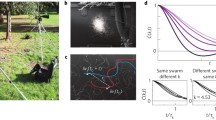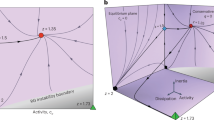Abstract
We present a progression of three distinct three-zone, continuum models for swarm behavior based on social interactions with neighbors in order to explain simple coherent structures in popular biological models of aggregations. In continuum models, individuals are replaced with density and velocity functions. Individual behavior is modeled with convolutions acting within three interaction zones corresponding to repulsion, orientation, and attraction, respectively. We begin with a variable-speed first-order model in which the velocity depends directly on the interactions. Next, we present a variable-speed second-order model. Finally, we present a constant-speed second-order model that is coordinated with popular individual-based models. For all three models, linear stability analysis shows that the growth or decay of perturbations in an infinite, uniform swarm depends on the strength of attraction relative to repulsion and orientation. We verify that the continuum models predict the behavior of a swarm of individuals by comparing the linear stability results with an individual-based model that uses the same social interaction kernels. In some unstable regimes, we observe that the uniform state will evolve toward a radially symmetric attractor with a variable density. In other unstable regimes, we observe an incoherent swarming state.
Similar content being viewed by others
References
Aoki, I. (1982). A simulation study on the schooling mechanism in fish. Bull. Jpn. Soc. Sci. Fisher., 48, 1081–1088.
Bonabeau, E. (1999). Scaling in animal group-size distributions. Proc. Natl. Acad. Sci. USA, 96(8), 4472–4477.
Bonabeau, E., & Dagorn, L. (1995). Possible universality in the size distribution of fish schools. Phys. Rev. E, 51(6), R5220–R5223.
Bonnans, J.-F., Gilbert, J. C., Lemarechal, C., & Sagatizabal, C. A. (2006). Numerical optimization—Theoretical and Practical Aspects. New York: Springer.
Camazine, S., Deneubourg, J.-L., Franks, N. R., Sneyd, J., Theraula, G., & Bonabeau, E. (2003). Self-organization in biological systems. Princeton: Princeton University Press.
Couzin, I., Krause, J., James, R., Ruxton, G., & Franks, N. (2002). Collective memory and spatial sorting in animal groups. J. Theor. Biol., 218, 1–11.
Cucker, F., & Smale, S. (2007). Emergent behavior in flocks. IEEE Trans. Autom. Control, 52(5), 852–862.
Eftimie, R., de Vries, G., Lewis, M.a., & Lutscher, F. (2007). Modeling group formation and activity patterns in self-organizing collectives of individuals. Bull. Math. Biol., 69(5), 1537–1565.
Giardina, I. (2008). Collective behavior in animal groups: theoretical models and empirical studies. HFSP J., 2(4), 205–219.
Huepe, C., & Aldana, M. (2004). Intermittency and clustering in a system of self-driven particles. Phys. Rev. Lett., 92, 168701.
Huth, A., & Wissel, C. (1992). The simulation of the movement of fish schools. J. Theor. Biol., 156, 365–385.
Kolpas, A., & Moehlis, J. (2009). Optimal switching between collective motion states for two agents. Appl. Math. Lett., 22(4), 4.
Kolpas, A., Moehlis, J., & Kevrekidis, I. G. (2007). Coarse-grained analysis of stochasticity-induced switching between collective motion states. Proc. Natl. Acad. Sci. USA, 104(14), 5931–5935.
Levine, H., Rappel, W. J., & Cohen, I. (2001). Self-organization in systems of self-propelled particles. Phys. Rev. E, 63, 017101.
Li, H., Kolpas, A., Moehlis, J., & Petzold, L. (2008). Parallel simulation for a fish schooling model on a general-purpose graphics processing unit. Concurr. Comput. Pract. Exp. doi:10.1002/cpe.1330.
Lissaman, P. B. S., & Shollenberger, C. A. (1970). Formation flight of birds. Science, 168, 1003–1005.
Lukeman, R., Li, Y.-X., & Edelstein-Keshet, L. (2010). Inferring individual rules from collective behavior. Proc. Natl. Acad. Sci. USA, 107(28), 12576–12580.
Mogilner, A., & Edelstein-Keshet, L. (1999). A non-local model for a swarm. J. Math. Biol., 38(6), 534–570.
Niwa, H.-S. (2003). Power-law versus exponential distributions of animal group sizes. J. Theor. Biol., 224(4), 451–457.
Paley, D., Leonard, N., Sepulchre, R., Grünbaum, D., & Parrish, J. K. (2007a). Spatial patterns in the dynamics of engineered and biological networks. IEEE Control Syst. Mag., 27(4), 89–105.
Paley, D. A., Leonard, N. E., Sepulchre, R., Grübaum, D., & Parrish, J. K. (2007b). Oscillator models and collective motion. IEEE Control Syst. Mag., 89–105. doi:10.1109/MCS.2007.384123.
Parrish, J. K. (1999). Complexity, pattern, and evolutionary trade-offs in animal aggregation. Science, 284(5411), 99–101.
Parrish, J. K., Viscido, S. V., & Grünbaum, D. (2002). Self-organized fish schools: an examination of emergent properties. Biol. Bull., 202, 296–305.
Partridge, B. (1982). The structure and function of fish schools. Sci. Am. doi:10.1038/scientificamerican0682-114.
Penrose, R., & Todd, J. A. (1956). On best approximate solutions of linear matrix equations. Math. Proc. Camb. Philos. Soc., 52(01), 17–19.
Raymond, J. R., & Evans, M. R. (2006). Flocking regimes in a simple lattice model. Phys. Rev. E, 73, 36112.
Reuter, H., & Breckling, B. (1994). Self-organization of fish schools: an object-oriented model. Ecol. Model., 75, 147–159.
Sinclair, A. R. E., & Norton-Griffiths, M. (1979). Serengeti: dynamics of an ecosystem. Chicago: University of Chicago.
Topaz, C., & Bertozzi, A. (2004). Swarming patterns in a two-dimensional kinematic model for biological groups. SIAM J. Appl. Math. doi:10.1137/S00361399034377424.
Topaz, C. M., Bertozzi, A. L., & Lewis, M. A. (2006). A nonlocal continuum model for biological aggregation. Bull. Math. Biol., 68(7), 1601–1623.
Uvarov, B. P. (1928). Grasshoppers and locusts. London: Imperial Bureau of Entomology.
Vicsek, T., Czirok, A., Ben-Jacob, E., Cohen, I., & Shochet, O. (1995). Novel type of phase transition in a system of self-driven particles. Phys. Rev. Lett., 75, 1226–1229.
Warburton, K., & Lazarus, J. (1991). Tendency-distance models of social cohesion in animal groups. J. Theor. Biol., 150, 473–488.
Author information
Authors and Affiliations
Corresponding author
Rights and permissions
About this article
Cite this article
Miller, J.M., Kolpas, A., Juchem Neto, J.P. et al. A Continuum Three-Zone Model for Swarms. Bull Math Biol 74, 536–561 (2012). https://doi.org/10.1007/s11538-011-9676-y
Received:
Accepted:
Published:
Issue Date:
DOI: https://doi.org/10.1007/s11538-011-9676-y




